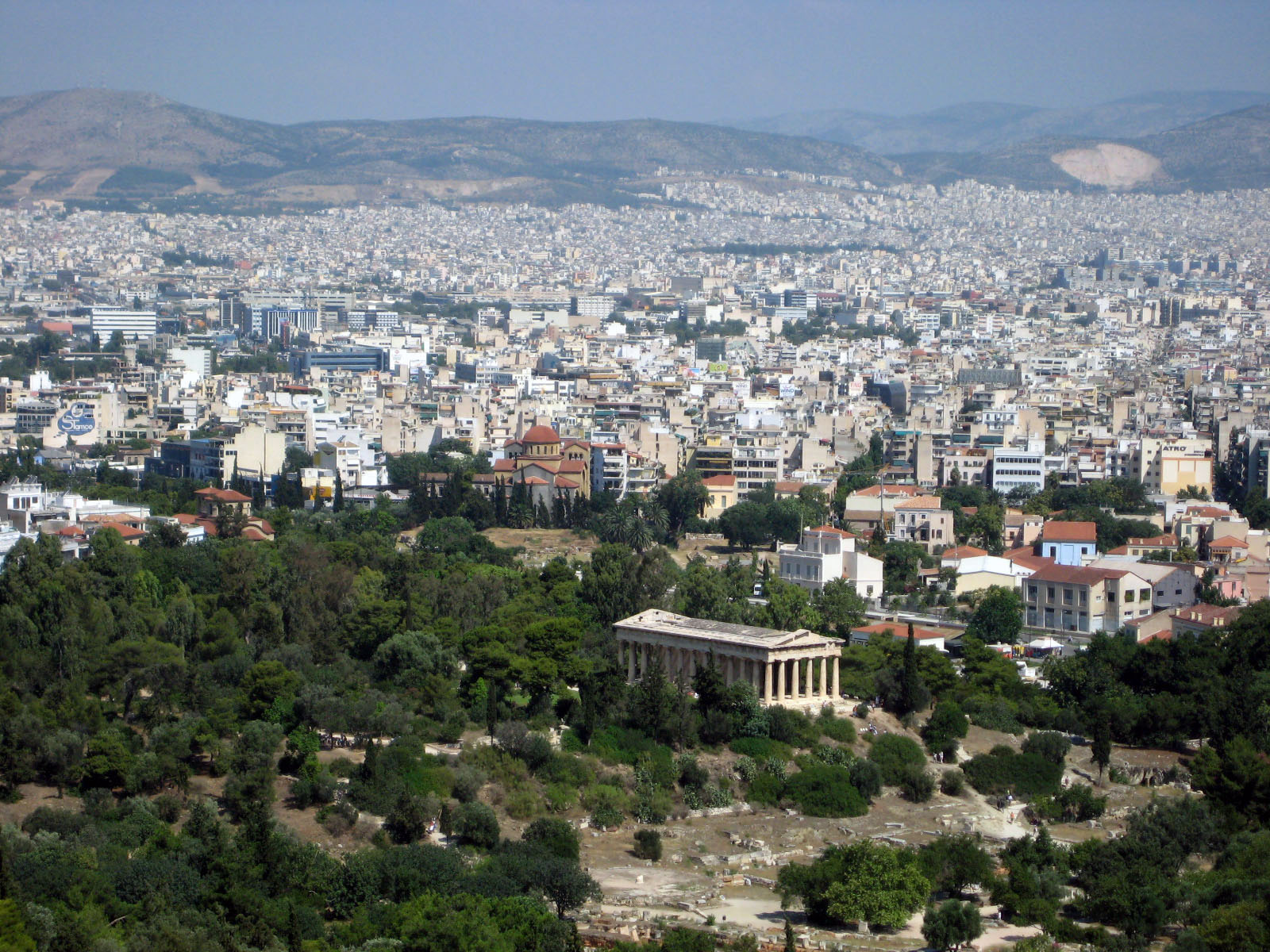 When American basketball superstar, Shaquille O’Neal came back from Athens last year, a reporter asked him if he went to the Parthenon. Shaq’s told him he went to a lot of clubs but he couldn’t remember the names of all of them.
When American basketball superstar, Shaquille O’Neal came back from Athens last year, a reporter asked him if he went to the Parthenon. Shaq’s told him he went to a lot of clubs but he couldn’t remember the names of all of them.
It kind of sums up a visit to modern Athens. For many it’s a city where evenings don’t begin till 10pm and the night clubs don’t close till 4am. Athens is full of life, all day and all night. The city that gave us democracy, philosophy, medicine, mathematics and pretty much the foundation of what we are today is now a city with a new metro system, restored and renovated old neighborhoods, shopping, great food and wine, easy access to some of the most beautiful islands and peninsulas in the world and amazing historical monuments and museums.
There is a lot of history here, close to 3,000 years worth; a lot of good and a lot of bad. After the golden days of the Age of Pericles in the 5th century BC, Greece fell into sadder times. Many in the world now think of them as poor people in a poor country. But “au contraire”, this is an amazingly rich country. The Greeks just look at life a little differently. They’d rather enjoy their lives than work themselves to death. Work can always wait till later. There is a lot of Zorba in all of them.
Today Athens is the 8th largest metropolitan area in Europe. It’s vibrant city and ranks as one of Europe’s great destinations. The new metro system is clean and convenient, but it’s even more amazing it ever got finished. Every dig below the street unearths a new artifact, which means the project gets shut down until the archaeologists get through with it, which could take a while. My imagination spins out of control whenever I think of what lies under these you think old neighborhoods. Money from the European Union is pouring in and this once poor country is showing signs of economic growth. Unfortunately though, the city suffers from a phenomenon known as temperature inversion that keeps smog and pollution close to the ground (it’s similar to Los Angeles). Over the years the pollution has damaged and degenerated most of the antiquities.
But, lucky for us, Zephyrus, Aeolus, Notus and the other wind gods have filled their cheeks and blown the pollution out of town. It’s blue skies, cool winds and lots of old marble dust.
We’re staying at the Ochre & Brown Hotel in the Thissio district. A few years ago this was one of the worst neighborhoods in Athens. Even though our hotel is really beautiful and the attention to it’s guests is 7 star quality, it’s on the outskirts of the Plaka (the city pedestrian center) and the Plaka-fication is still a few years off. All around us the neighborhood is rebuilding, old building skeletons are being renovation into banks, upscale shops and yes, there’s even an Applebee’s Restaurant a few blocks away. Mmmm, maybe it is the trendy section and we just don’t know it.

The Athens flea market has lived in this neighborhood for many, many years and if it did gentrify too much, the stalls, tables and blanket spread out along the sidewalks might seem a bit out of place.
The Sunday market is the largest and it hit us as soon as we walked out the front door of the hotel. Anyone who has a box of junk is out on the street hoping someone will give them a few euros for it. You could even buy a US quarter for 50 euro cents (about 70 cents US). Now that’s inflation. It a lot fun searching through all the junk, everything from old dishes to pre World War II weapons, 19th century musical instruments and estate furniture and really spooky old medical tools.
It’s hard to tell where the flea market ends and the souvenir, jewelry, clothing, sandal, ancient reproductions and sponges of the Plaka begin. As one Greek local told us, “over there is all Plaka”.
Our agenda was pretty much confirmed when we were told the Acropolis Hill would be closed on Saturday and Sunday due to the strike. We found out later that the strike was originally scheduled for 4 days but all the local Travel Agents joined together and convinced the strikers that 4 days was too much. Too many people had come to Athens just to see to the Acropolis. The strike would give the city a really bad name in the tourism. The strikers agreed. The strike was reduced to 2 days only. I’m sure a lot of people were disappointed, but we just turned the other direction and headed up to the Archaeology museum.
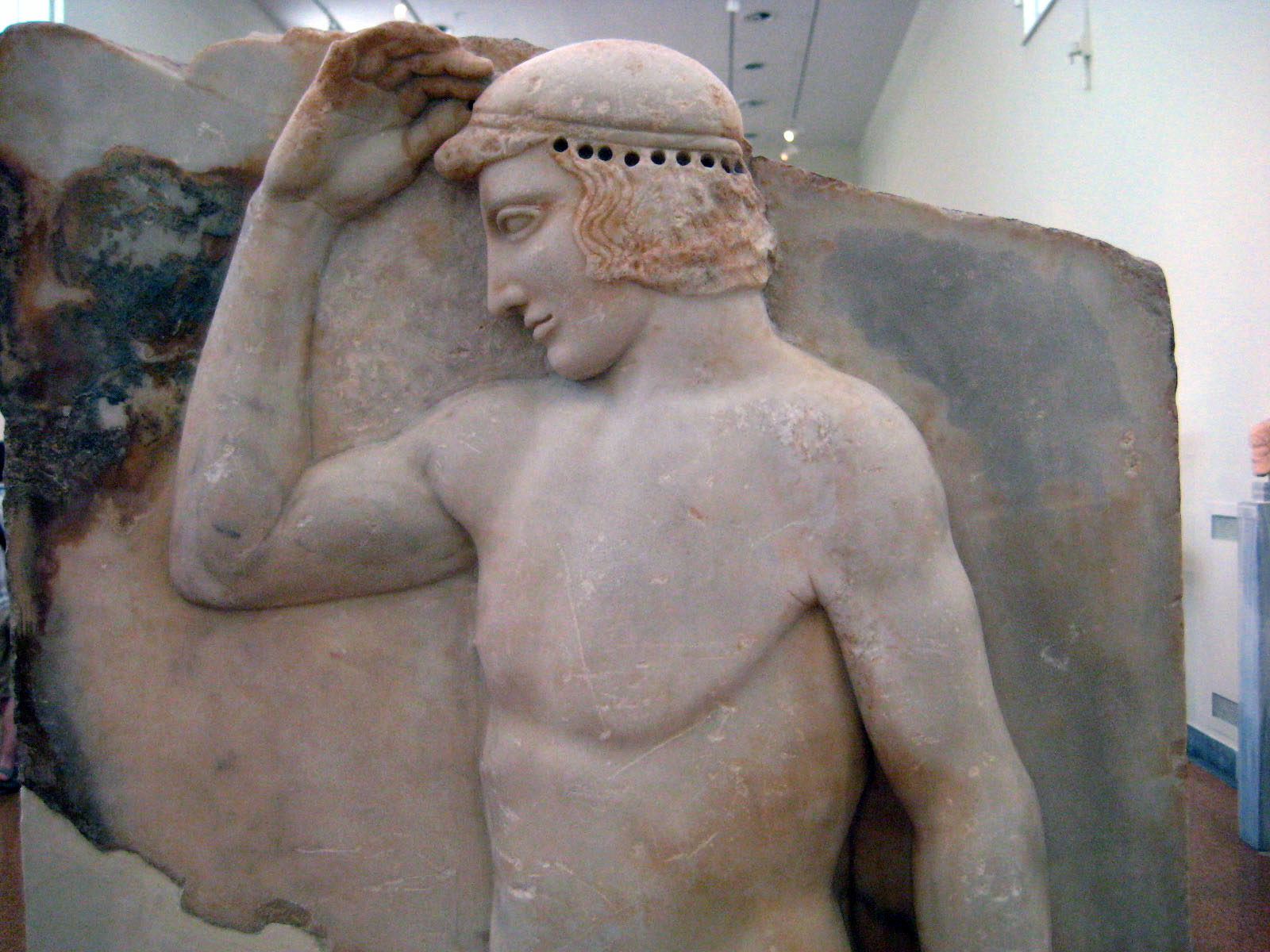 This museum might not be the biggest, but if you’re interested in ancient Greek and Roman history, it’s a great one. Sure, many of the great finds in Greece were carted away to London, Berlin, New York, Paris or anywhere else in the world besides Greece, but what they have collected here is well worth the ticket (both airfare and museum).
This museum might not be the biggest, but if you’re interested in ancient Greek and Roman history, it’s a great one. Sure, many of the great finds in Greece were carted away to London, Berlin, New York, Paris or anywhere else in the world besides Greece, but what they have collected here is well worth the ticket (both airfare and museum).
There are 2500 year old Cycladic pieces, enormous bronze and marble pieces dating from the classical days of Greece and Rome, a 2000 year old astrolabe with 32 moving gears and the astounding burial treasure of Myceanae.
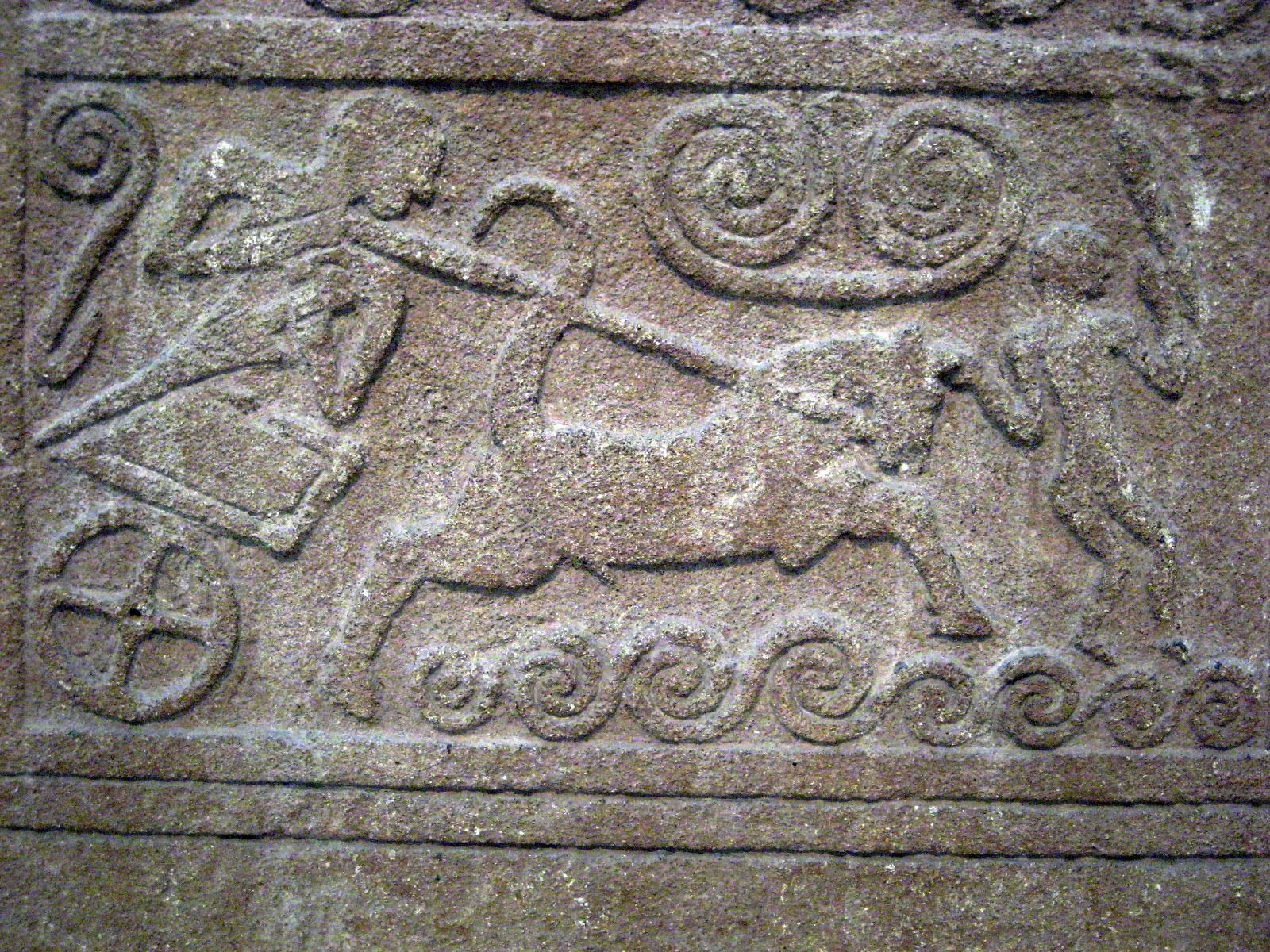 Heindrich Schliemann, the German treasure hunter who re-discovered Troy completed his Homeric resurrection when he found the circular burial chambers of Mycenae in the late 1800’s.
Heindrich Schliemann, the German treasure hunter who re-discovered Troy completed his Homeric resurrection when he found the circular burial chambers of Mycenae in the late 1800’s.
Even though the Mycenaean dig goes back to 4,000 BC, Schleimann was more interested in anything that would give credibility to the Homeric epic of Helen, Menalaus, Agamemnon and the cursed family of Atreus. As a “leap of faith” treasure hunter, Schliemann was certain he found the graves of Clytaemnestra and Aegisthus and the gold death mask of Agamemnon.
 On November 16, 1876, he wrote a letter to King George of Greece and said, “it is with great pleasure that I inform you that I have discovered the tombs which, according to Pausanais’ account belong to Agamemnon, Kassandra and their comrades who were murdered by Klytaemnestra and her paramour Aegisthus, during a feast… Inside the tombs I have discovered fabulous treasure and ancient objects of solid gold. These treasure alone are enought to fill a large museum which will become the most famous in the world and will attract myriads of foreigners to Greece from many lands.”
On November 16, 1876, he wrote a letter to King George of Greece and said, “it is with great pleasure that I inform you that I have discovered the tombs which, according to Pausanais’ account belong to Agamemnon, Kassandra and their comrades who were murdered by Klytaemnestra and her paramour Aegisthus, during a feast… Inside the tombs I have discovered fabulous treasure and ancient objects of solid gold. These treasure alone are enought to fill a large museum which will become the most famous in the world and will attract myriads of foreigners to Greece from many lands.”
He was right, it is enought to fill a museum. The discovery takes up almost one third of the Athen’s Museums. Schleimann, however, was a man of dubious distinction and his life was filled with controversy. Some accounts have said he hired a goldsmith to manufacture some artifacts in Mycenaean style, and planted them at the site to make the find more impressive. Hey, his wife never denied it.. But nonetheless, the room of Mycenaen artifacts is amazing. We made one visit before we went to the site of Mycenae but when we came back after visiting the site, it all made sense.
If you’re coming to Greece, we recommend to save Athens for the end. The treasures in the Museum of Archaeology makes a lot more sense after you visit the monuments.
One of our reasons for coming back to Athens was so that we could pick up a cycladian statue from the Archeology museum shop. When we were here in 2000, the shop was closed that day. When we got to the museum this time, the shop was closed for renovations. The authorized national museum shop makes reproductions that look as good as the originals (and much better than the resin and soft stone statues sold in the Plaka). Lucky for us there are state authorized museum shops all over Greece and we did find our Cycladic head. Now we have to carry it in our bags with us for a more than a month.
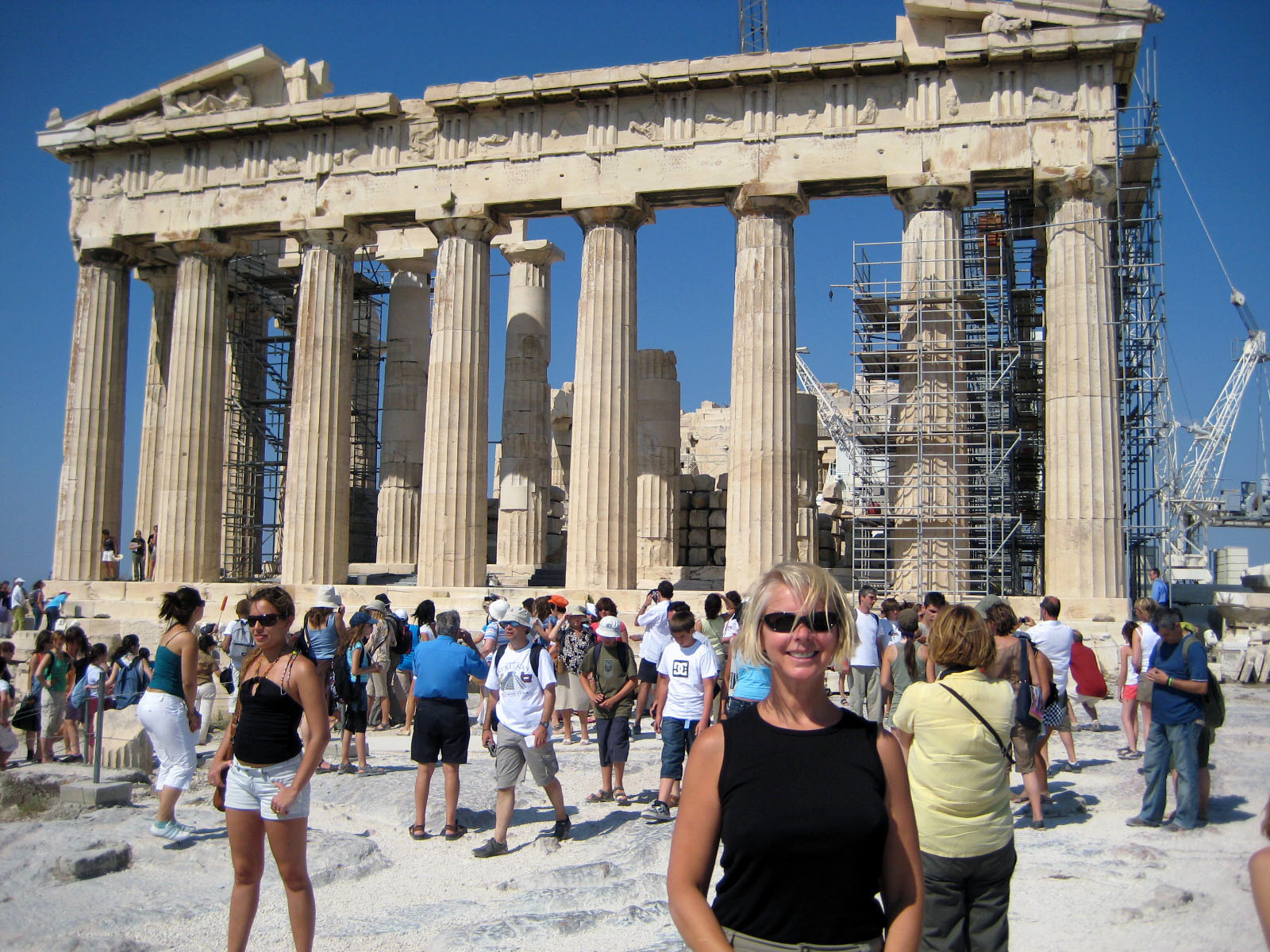 There’s a beautiful stone path that starts at the brand new Thissio metro (a three minute walk from out hotel) and winds up the hill to the Acropolis. It’s an easy 15 minute walk away from the chaos of the city with an amazing view of the ancient agora.
There’s a beautiful stone path that starts at the brand new Thissio metro (a three minute walk from out hotel) and winds up the hill to the Acropolis. It’s an easy 15 minute walk away from the chaos of the city with an amazing view of the ancient agora.
After a weekend strike, we knew it would be crowded up on the hill and sure enough, as we got to the top, there were the thousands waiting to get through the entrance. Walking up around the Acropolis hill is perilous. Over the years, the carved stone walkways and steps are slippery smooth from years of wear. Leather soles and cute little teddy heels are not proper footwear, yet try to tell that to the thousands of tourists coming from the cruise ships. People were almost thrown off the hill from inappropriate shoes and gusting winds. At one point I was climbing up some rocks and an elderly lady pushed me back down so she could get a better view of the theatre of Dionysius. If I wasn’t wearing good grips on the bottom of feet, I would have tumbled down the mountain.
When we were here in 2000, the ancient 5th century BC temples were dirty, weary and deteriorated, but we were allowed to wander at will inside and out. What a treat it was. When you’re inside the temples you can really feel their power, especially in the Parthenon. From the day it was completed, it had a power over all who lived in it’s shadow. Athena’s temple protected the city during the golden age and at one point was even used as a treasury for the Delian League, the Greek united city states formed during the Persian War.
 In the 6th century it was converted to a Christian church to the Holy Virgin and when the Ottoman empire took the city in the 15th century, it was turned into a Mosque.
In the 6th century it was converted to a Christian church to the Holy Virgin and when the Ottoman empire took the city in the 15th century, it was turned into a Mosque.
The Ottomans used part of the temple as a munitions dump and on September 28, 1687 an errant bomb from a Venetian bombardment hit the munitions stash. KABOOM. The Ottomans won the war and soon after, the Sultan gave Thomas Bruce, the 7th Earl of Elgin permission to make sketches and rubbings of the reliefs, telling him it would be all right to move things out of the way in order to get a better view of the Parthenon friezes. Lord Elgin’s interpretation was he could move the friezes (and lots more) to London, which (at great disapproval to the Greek government) is where they’ve remained for over 300 years. Well, he did move them out of the way.
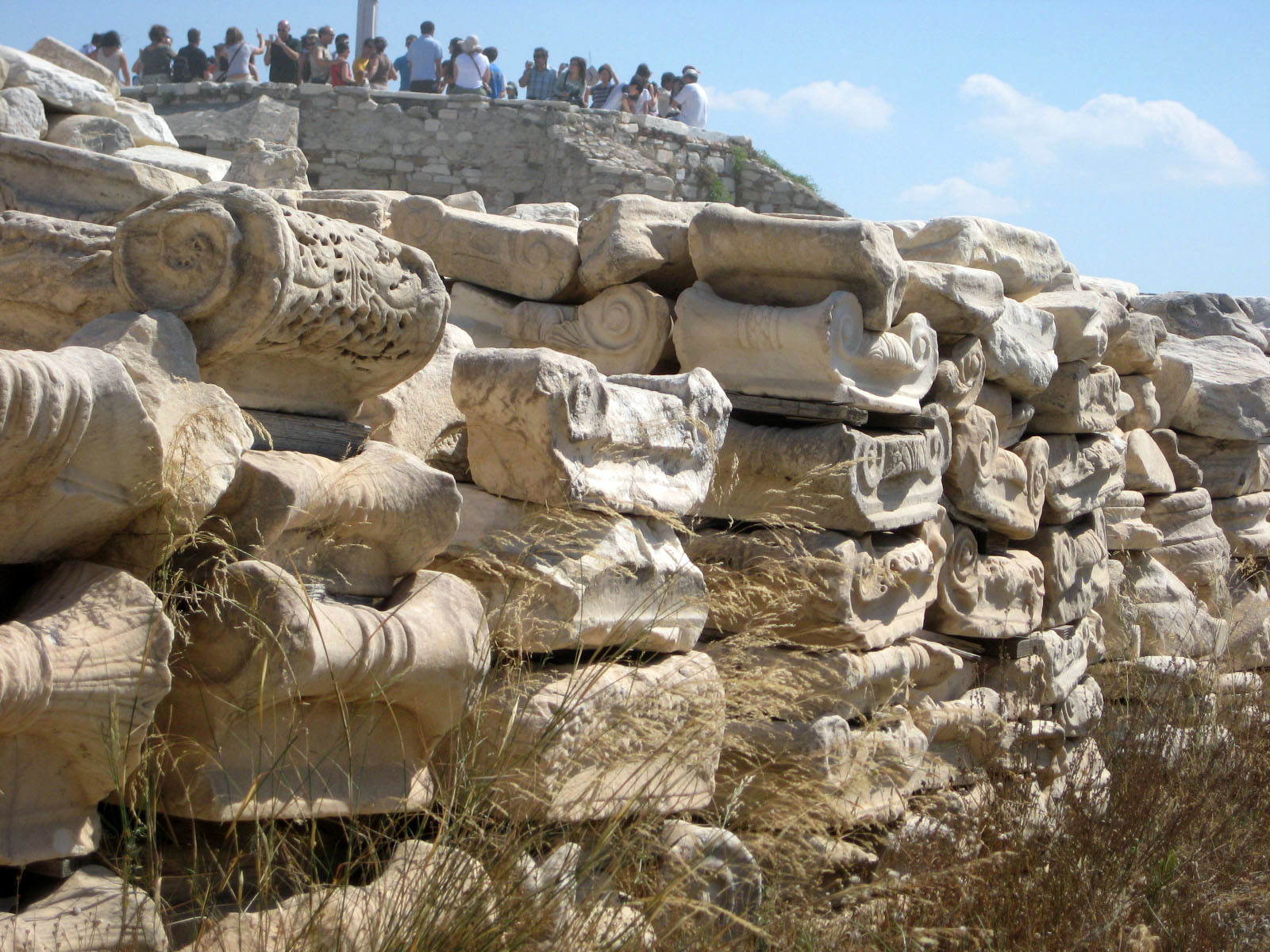 In 2000, the exploded pieces of the Parthenon were still piled up in the same 1687 location, waiting to be put back together. We were told the pieces were being tagged and sorted and a massive “Humpty Dumpty” restoration would be finished before the 2004 Athens Olympics.
In 2000, the exploded pieces of the Parthenon were still piled up in the same 1687 location, waiting to be put back together. We were told the pieces were being tagged and sorted and a massive “Humpty Dumpty” restoration would be finished before the 2004 Athens Olympics.
Some of the work was completed in 2004, but they’re still a long way off. And as for using the old pieces? Well the rubble was cleaned up but who knows what is going on. There are piles of pediments, piles of capitals and piles of stones all over the place. Most of the walls and columns are being rebuilt with new marble mined from the same quarry the original stone was pulled from. Existing elements are being cleaned and preserved. Stone is being cut on site and lifted into position with modern cranes. It’s amazing the temple rebuilders can work with the winds, the marble dust and all the tourists. We’ll have to come back just to check up on the progress, and to see the new Acropolis museum. It was also supposed to open for the 2004 Olympics but that never happened. The signs we saw said the new building will open in May 2007.
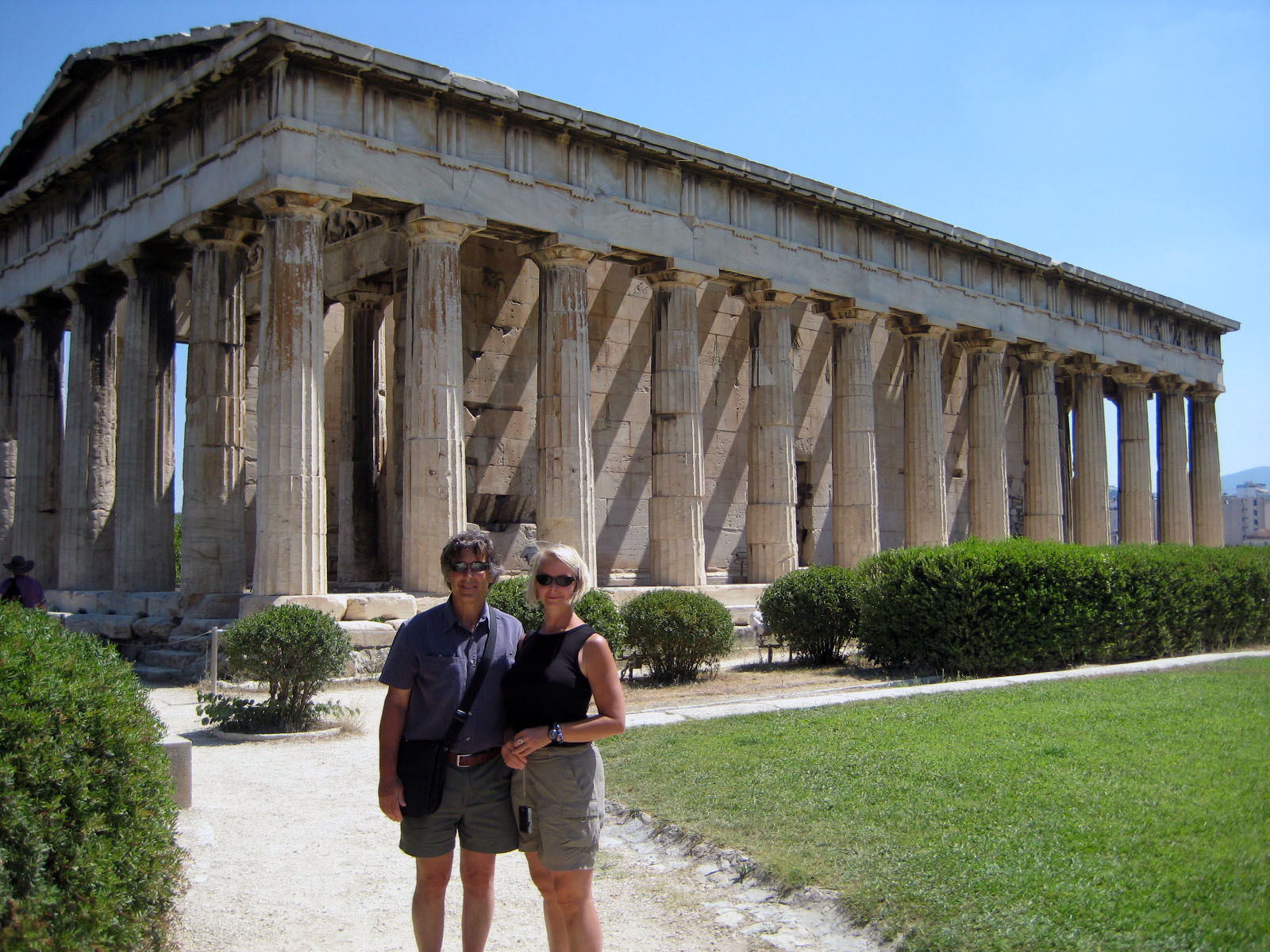 If you walk down the Acropolis hill, there’s a very convenient entrance to the ancient agora, the core of life in ancient Athens and Rome. The restoration hasn’t hit the agora yet, but once the Acropolis is finished, restoration fever will probably hit the Temple of Hephestus. Right now it’s rumored to be the best preserved ancient Greek temple in the world. It still has all its columns and pediments intact. It still has most of the original roof, although it is caving in. The friezes however, have been looted and what remains is badly damaged by the centuries of pollution.
If you walk down the Acropolis hill, there’s a very convenient entrance to the ancient agora, the core of life in ancient Athens and Rome. The restoration hasn’t hit the agora yet, but once the Acropolis is finished, restoration fever will probably hit the Temple of Hephestus. Right now it’s rumored to be the best preserved ancient Greek temple in the world. It still has all its columns and pediments intact. It still has most of the original roof, although it is caving in. The friezes however, have been looted and what remains is badly damaged by the centuries of pollution.
For a long while it was referred to as the Thission Temple (hence the Thissio neighborhood) after the Greek hero, Theseus, who defeated the Monitor and accidentally caused the death of his dad Aegeas when he forgot to raise the white sails on the ship back home. Aegeus jumped into the sea when he thought his son was killed by the Monitor. “Sorry Dad, I knew there was something I forgot to do.”
For many years it was believed Theseus was buried in the temple but the bones were never discovered. Now they think he’s buried closer to the Acropolis.
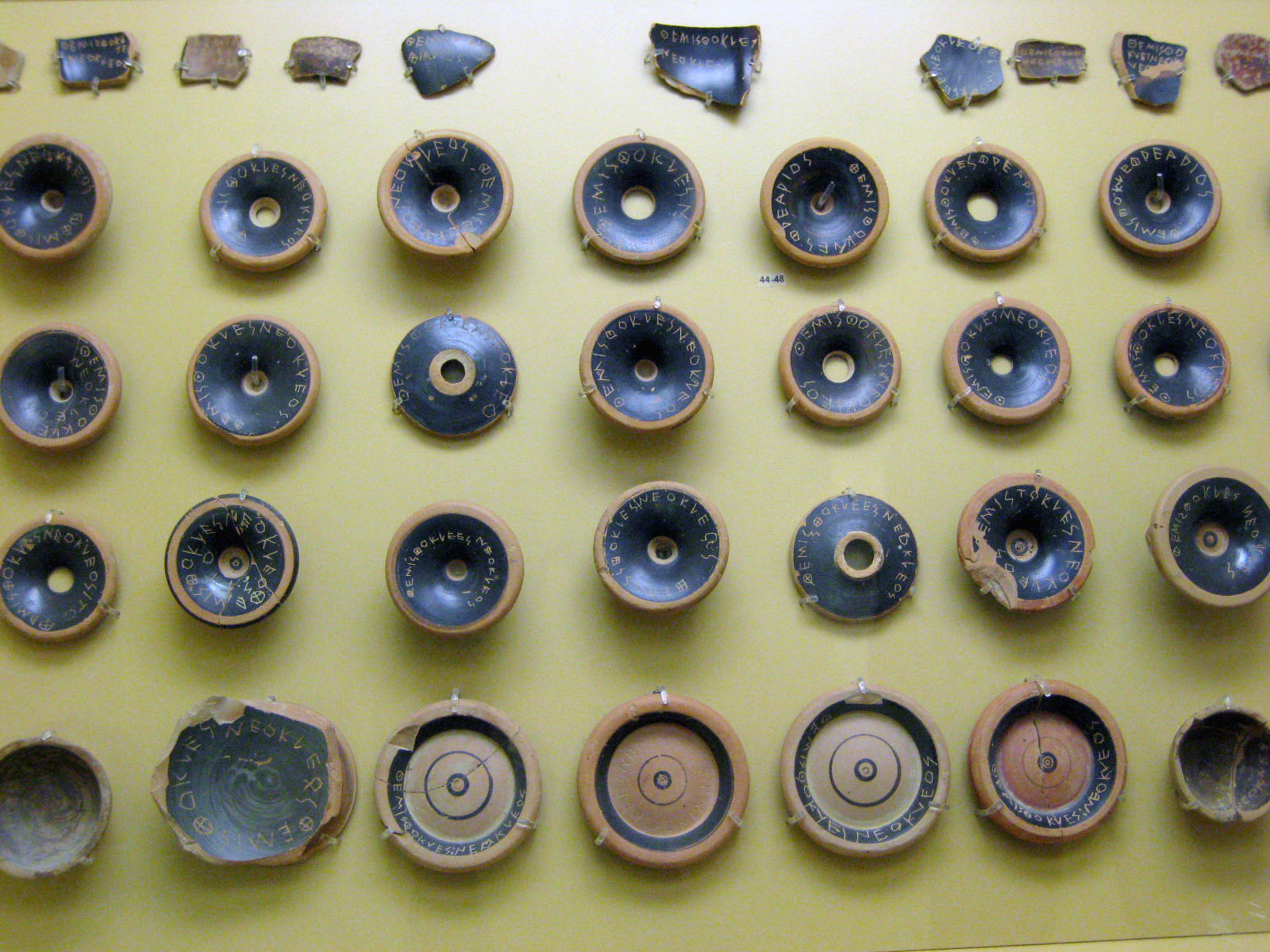 The Agora Museum is another real treat with some great treasures. There is a perfume bottle in the shape of a nude man, an ancient potty chair complete with operating instructions and a wall of ostrakas. The citizens could write down the name of any citizen they didn’t like on these clay donuts and if there were enough votes, the citizen would be ostracized from the city for an agreed upon period of time, usually a year. Now that’s democracy.
The Agora Museum is another real treat with some great treasures. There is a perfume bottle in the shape of a nude man, an ancient potty chair complete with operating instructions and a wall of ostrakas. The citizens could write down the name of any citizen they didn’t like on these clay donuts and if there were enough votes, the citizen would be ostracized from the city for an agreed upon period of time, usually a year. Now that’s democracy.
Adrianou Street is one of the main routes through the Plaka and as you get closer to the Thissio metro station, the crowd thins out and the view of the Acropolis, the ancient Agora and the Hephestus temple are right there in front of you. This is where we’d go for café sitting, cold mineral water and beer and a good meal of Greek food. Our best meal was at a place called Ku Zi Na. The restaurant is in a renovated 19th century Greek mansion with the best view of the Acropolis and Hephestus temple. From the top floor dining area, it feels like you can almost reach out and touch the old temples.
One last plug. In 2000, I found the website of Matt Barrett’s Greece. He is the fountain of everything related to your visit to Greece. We highly recommend him.
You must be logged in to post a comment.